Papers by Monalisa Trentini
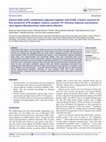
Human Vaccines & Immunotherapeutics, Sep 22, 2017
Tuberculosis (TB) remains a main public health concern and 10.4 million new cases occurred in 201... more Tuberculosis (TB) remains a main public health concern and 10.4 million new cases occurred in 2015 around the world. BCG is the only approved vaccine against TB, but has variable efficacy and new vaccines are needed. We developed two new mTB vaccine candidates based on the recombinant fusion proteins, rCMX and rECMX formulated with Advax4, a new combination adjuvant combining delta inulin, CpG oligonucleotide and murabutide. BALB/c mice were immunized three times intramuscularly with these vaccine formulations. Injection of Advax4 alone increased the percentage of lymphatic endothelial cells and activated macrophages (F480/CD11b C) in the draining lymph nodes consistent with a chemotactic adjuvant effect. Advax4CCMX and Advax4CECMX induced the highest levels of IgG1 and IgG2a antibodies against rCMX and rECMX, respectively. Immunized mice challenged with Mycobacterium tuberculosis (Mtb) had increased vaccine-specific Th1 responses in the lungs together with reduced Mtbassociated alveolar damage, although only the Advax4CECMX vaccine demonstrated significant reduction of lung bacterial load. This study confirmed Advax4CECMX as a potential TB vaccine candidate, with potential for further optimization and clinical development.
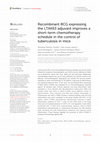
Frontiers in Immunology, Aug 31, 2022
Tuberculosis (TB) is one of the deadliest infectious diseases around the world. Prevention is bas... more Tuberculosis (TB) is one of the deadliest infectious diseases around the world. Prevention is based on the prophylactic use of BCG vaccine, effective in infants but as protection wanes with time, adults are less protected. Additionally, chemotherapy requires the use of many antibiotics for several months to be effective. Immunotherapeutic approaches can activate the immune system, intending to assist chemotherapy of TB patients, improving its effectiveness, and reducing treatment time. In this work, the recombinant BCG expressing LTAK63 (rBCG-LTAK63) was evaluated for its immunotherapeutic potential against TB. Bacillary load, immune response, and lung inflammation were evaluated in mice infected with Mycobacterium tuberculosis (Mtb) and treated either with BCG or rBCG-LTAK63 using different routes of administration. Mice infected with Mtb and treated intranasally or intravenously with rBCG-LTAK63 showed a reduced bacillary load and lung inflammatory area when compared to the group treated with BCG. In the spleen, rBCG-LTAK63 administered intravenously induced a higher inflammatory response of CD4 + T cells. On the other hand, in the lungs there was an increased presence of CD4 + IL-10 + and regulatory T cells. When combined with a short-term chemotherapy regimen, rBCG-LTAK63 administered subcutaneously or intravenously decreases the Mtb bacillary load, increases the anti-inflammatory response, and reduces tissue inflammation. These findings highlight the potential of rBCG-LTAK63 in assisting chemotherapy against Mtb.
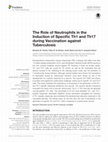
Frontiers in Microbiology, Jun 10, 2016
Mycobacterium tuberculosis causes tuberculosis (TB), a disease that killed more than 1.5 million ... more Mycobacterium tuberculosis causes tuberculosis (TB), a disease that killed more than 1.5 million people worldwide in 2014, and the Bacillus Calmette Guérin (BCG) vaccine is the only currently available vaccine against TB. However, it does not protect adults. Th1 and Th17 cells are crucial for TB control, as well as the neutrophils that are directly involved in DC trafficking to the draining lymph nodes and the activation of T lymphocytes during infection. Although several studies have shown the importance of neutrophils during M. tuberculosis infection, none have shown its role in the development of a specific response to a vaccine. The vaccine mc 2-CMX was shown to protect mice against M. tuberculosis challenge, mainly due to specific Th1 and Th17 cells. This study evaluated the importance of neutrophils in the generation of the Th1and Th17-specific responses elicited by this vaccine. The vaccine injection induced a neutrophil rich lesion with a necrotic central area. The IL-17 KO mice did not generate vaccine-specific Th1 cells. The vaccinated IL-22 KO mice exhibited Th1-and Th17specific responses. Neutrophil depletion during vaccination abrogated the induction of Th1-specific responses and prohibited the bacterial load reduction observed in the vaccinated animals. The results show, for the first time, the role of neutrophils in the generation of specific Th1 and Th17 cells in response to a tuberculosis vaccine.

Journal of Immunology, May 1, 2015
Introduction: In 2013, 1.5 million died from TB, the BCG vaccine is the only TB vaccine currently... more Introduction: In 2013, 1.5 million died from TB, the BCG vaccine is the only TB vaccine currently available, but does not protect adults. The mc2CMX vaccine developed by our group was able to generate similar protection in mice, but induced higher levels of Th17 cells when compared with BCG. Objective: To study the role of Th17 cells in the protection induced by mc2CMX vaccine. Methodology: WT, IL22KO, and IL17KO mice were immunized twice with mc2CMX. Mice were challenged with Mycobacterium tuberculosis. Fifteen days after the last immunization, the lesions were collected and stained with HE, and the spleen cells were analyzed by flow cytometry before and after Mtb challenge. Results: Although WT mice induced vaccine lesions showing peripheral neutrophilia, central necrosis and few macrophages, both KO mice strains showed reduced injuries with lower neutrophils migration. Only IL-22KO and WT vaccinated mice presented vaccine specific Th1 and Th17 responses and reduced the lung and spleen bacterial load 30 days after challenging with Mtb. Adoptive transfer of splenocytes from vaccinated WT mice to naïve IL17KO and WT animals restored partially the protection. WT mice neutrophils depletion provoked reduction in lung specific Th1 and Th17 responses after mc2CMX vaccination. Conclusion: The results show for the first time, the protective role of vaccine induced Th17 specific cells, and also the assistance of neutrophils in the generation of such protection against TB.

A tuberculose e uma doenca que acomete milhoes de individuos no mundo. No Brasil esta doenca e a ... more A tuberculose e uma doenca que acomete milhoes de individuos no mundo. No Brasil esta doenca e a segunda causa de morte por doenca infectocontagiosa, embora o Pais tenha reduzido a metade o numero de mortes por tuberculose. Um dos principais problemas para o controle desta doenca e a baixa eficacia da vacina BCG em proteger adultos. O desenvolvimento de novas vacinas que induzam uma resposta imune eficaz e duradoura, ou que estimulem a BCG a aumentar a imunidade ja existente e de grande valia. O objetivo desta dissertacao foi avaliar e comparar se lipossomas microestruturados contendo HspX em diferentes formulacoes vacinais, associados ou nao a adjuvantes conhecidos: CpG DNA ou MPL poderiam influenciar na resposta imune humoral e celular de camundongos contra o Mycobacterium tuberculosis. Nossos resultados mostram que lipossomas microestruturados contendo HspX foram imunogenicos e antigenicos. As formulacoes vacinais contendo o adjuvante CpG DNA foram as principais indutoras de resposta humoral e celular especifica, principalmente com producao de IFN- e TNF- tanto por linfocitos T CD4+ quanto CD8+. Formulacoes vacinais contendo HspX e MPL induziram resposta imune humoral e ativaram principalmente linfocitos T CD8. A formulacao vacinal que melhor reduziu as lesoes pulmonares provocadas pelo Mycobacterium tuberculosis, assim como a carga bacilar foi a composta por lipossomas microestruturados contendo HspX e CpG DNA. Estes resultados demonstram pela primeira vez o uso de lipossomas microestruturados em formulacoes de vacinas com o antigeno HspX para a tuberculose.
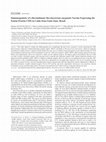
Journal of Veterinary Medical Science, 2014
This study aimed to evaluate the immunogenicity of a recombinant Mycobacterium smegmatis vaccine ... more This study aimed to evaluate the immunogenicity of a recombinant Mycobacterium smegmatis vaccine expressing the CMX fusion protein composed of immunodominant epitopes Ag85C, MPT51 and HspX of Mycobacterium tuberculosis, which are important mycobacteria virulence factors. A group of Nelore heifers that were 10 to 12 months of age and negative for the tuberculin skin test (TsT) were immunized with four doses of the recombinant vaccine mc 2-CMX (M. smegmatis-Ag85C-MPT51-HspX) during a period of one year. Before each immunization, blood was collected to obtain sera for antibody analysis. serological analysis demonstrated that mc 2-CMX was able to induce a humoral response with increased levels of specific IgG antibodies against CMX, despite minimum antibody levels being detected for individual Ag85C, MPT51 or HspX recombinant antigens. However, there was no significant increase in specific CD4 + IFN-γ-positive T cells. Lymphadenomegaly was observed in superficial cervical lymph nodes adjacent to the site of vaccination among mc 2-CMX-vaccinated bovines, and the histopathological analysis demonstrated follicular hyperplasia without inflammatory infiltrate or granuloma formation. Animals remained negative for the TsT until the end of the experiments, showing no cross-reactivity with the recombinant vaccine and tuberculin proteins. We discuss the potential of mc 2-CMX to induce an immune response in cattle.
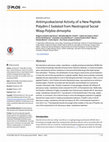
PLOS ONE, Mar 1, 2016
Mycobacterium abscessus subsp. massiliense, a rapidly growing mycobacteria (RGM) that is becoming... more Mycobacterium abscessus subsp. massiliense, a rapidly growing mycobacteria (RGM) that is becoming increasingly important among human infectious diseases, is virulent and pathogenic and presents intrinsic resistance to several antimicrobial drugs that might hamper their elimination. Therefore, the identification of new drugs to improve the current treatment or lower the risk of inducing resistance is urgently needed. Wasp venom primarily comprises peptides that are responsible for most of the biological activities in this poison. Here, a novel peptide Polydim-I, from Polybia dimorpha Neotropical wasp, was explored as an antimycobacterial agent. Polydim-I provoked cell wall disruption and exhibited non-cytotoxicity towards mammalian cells. Polydim-I treatment of macrophages infected with different M. abscessus subsp. massiliense strains reduced 40 to 50% of the bacterial load. Additionally, the Polydim-I treatment of highly susceptible mice intravenously infected with M. abscessus subsp. massiliense induced 0.8 to 1 log reduction of the bacterial load in the lungs, spleen, and liver. In conclusion, this is the first study to show the therapeutic potential of a peptide derived from wasp venom in treating mycobacteria infections. Polydim-I acts on the M. abscessus subsp. massiliense cell wall and reduce 40-90% of the bacterial load both in vitro and in vivo. The presented results encourage further studies on the use of Polydim-I as one of the components for M. abscessus subsp. massiliense treatment.
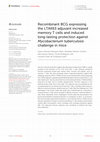
Frontiers in Immunology, Jul 13, 2023
Vaccine-induced protection against Mycobacterium tuberculosis (Mtb) is usually ascribed to the in... more Vaccine-induced protection against Mycobacterium tuberculosis (Mtb) is usually ascribed to the induction of Th1, Th17, and CD8 + T cells. However, protective immune responses should also involve other immune cell subsets, such as memory T cells. We have previously shown improved protection against Mtb challenge using the rBCG-LTAK63 vaccine (a recombinant BCG strain expressing the LTAK63 adjuvant, a genetically detoxified derivative of the A subunit from E. coli heat-labile toxin). Here we show that mice immunized with rBCG-LTAK63 exhibit a long-term (at least until 6 months) polyfunctional Th1/Th17 response in the draining lymph nodes and in the lungs. This response was accompanied by the increased presence of a diverse set of memory T cells, including central memory, effector memory and tissue-resident memory T cells. After the challenge, the T cell phenotype in the lymph nodes and lungs were characterized by a decrease in central memory T cells, and an increase in effector memory T cells and effector T cells. More importantly, when challenged 6 months after the immunization, this group demonstrated increased protection in comparison to BCG. In conclusion, this work provides experimental evidence in mice that the rBCG-LTAK63 vaccine induces a persistent increase in memory and effector T cell numbers until at least 6 months after immunization, which correlates with increased protection against Mtb. This improved immune response may contribute to enhance the longterm protection.
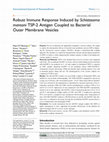
International Journal of Nanomedicine, Oct 1, 2021
The use of adjuvants can significantly strengthen a vaccine's efficacy. We sought to explore the ... more The use of adjuvants can significantly strengthen a vaccine's efficacy. We sought to explore the immunization efficacy of bacterial outer membrane vesicles (OMVs) displaying the Schistosoma mansoni antigen, SmTSP-2, through a biotin-rhizavidin coupling approach. The rationale is to exploit the nanoparticulate structure and the adjuvant properties of OMVs to induce a robust antigen-specific immune response, in light of developing new vaccines against S. mansoni. Materials and Methods: OMVs were obtained from Neisseria lactamica and conjugated with biotin. The recombinant SmTSP-2 in fusion with the biotin-binding protein rhizavidin (rRzvSmTSP-2) was produced in E. coli and coupled to biotinylated OMVs to generate an OMV complex displaying SmTSP-2 on the membrane surface (OMV:rSmTSP-2). Transmission electron microscopy (TEM) and dynamic light scattering analysis were used to determine particle charge and size. The immunogenicity of the vaccine complex was evaluated in C57BL/6 mice. Results: The rRzvSmTSP-2 protein was successfully coupled to biotinylated OMVs and purified by size-exclusion chromatography. The OMV:rSmTSP-2 nanoparticles showed an average size of 200 nm, with zeta potential around-28 mV. Mouse Bone Marrow Dendritic Cells were activated by the nanoparticles as determined by increased expression of the costimulatory molecules CD40 and CD86, and the proinflammatory cytokines (TNF-α, IL-6 and IL-12) or IL-10. Splenocytes of mice immunized with OMV:rSmTSP-2 nanoparticles reacted to an in vitro challenge with SmTSP-2 with an increased production of IL-6, IL-10 and IL-17 and displayed a higher number of CD4+ and CD8+ T lymphocytes expressing IFN-γ, IL-4 and IL-2, compared to mice immunized with the antigen alone. Immunization of mice with OMV:rSmTSP-2 induced a 100-fold increase in specific anti-SmTSP-2 IgG antibody titers, as compared to the group receiving the recombinant rSmTSP-2 protein alone or even co-administered with unconjugated OMV. Conclusion: Our results demonstrate that the SmTSP-2 antigen coupled with OMVs is highly immunogenic in mice, supporting the potential effectiveness of this platform for improved antigen delivery in novel vaccine strategies.
Expert Review of Vaccines, Jul 13, 2021
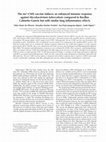
Memorias Do Instituto Oswaldo Cruz, Apr 1, 2016
Although the attenuated Mycobacterium bovis Bacillus Calmette-Guérin (BCG) vaccine has been used ... more Although the attenuated Mycobacterium bovis Bacillus Calmette-Guérin (BCG) vaccine has been used since 1921, tuberculosis (TB) control still proceeds at a slow pace. The main reason is the variable efficacy of BCG protection against TB among adults, which ranges from 0-80%. Subsequently, the mc 2-CMX vaccine was developed with promising results. Nonetheless, this recombinant vaccine needs to be compared to the standard BCG vaccine. The objective of this study was to evaluate the immune response induced by mc 2-CMX and compare it to the response generated by BCG. BALB/c mice were immunised with both vaccines and challenged with Mycobacterium tuberculosis (Mtb). The immune and inflammatory responses were evaluated by ELISA, flow cytometry, and histopathology. Mice vaccinated with mc 2-CMX and challenged with Mtb induced an increase in the IgG1 and IgG2 levels against CMX as well as recalled specific CD4 + T-cells that produced T-helper 1 cytokines in the lungs and spleen compared with BCG vaccinated and challenged mice. Both vaccines reduced the lung inflammatory pathology induced by the Mtb infection. The mc 2-CMX vaccine induces a humoral and cellular response that is superior to BCG and is efficiently recalled after challenge with Mtb, although both vaccines induced similar inflammatory reductions.
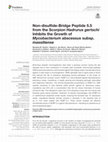
Frontiers in Microbiology, Feb 22, 2017
Multi-drug resistant microorganisms have been a growing concern during the last decades due to th... more Multi-drug resistant microorganisms have been a growing concern during the last decades due to their contribution in mortality rates worldwide. Antimicrobial peptides (AMPs) are broad spectrum antimicrobial agents that display potent microbicidal activity against a wide range of microorganisms. AMPs generally have a rapid mode of action that reduces the risk of resistance developing among pathogens. In this study, an AMP derived from scorpion venom, NDBP-5.5, was evaluated against Mycobacterium abscessus subsp. massiliense, a rapidly growing and emerging pathogen associated with healthcare infections. The minimal bactericidal concentration of NDBP-5.5, AMP quantity necessary to stop bacteria visible growth, against M. abscessus subsp. massiliense was 200 µM, a concentration that did not induce hemolysis of human red blood cells. The therapeutic index was 3.05 indicating a drug with low toxicity and therefore good clinical potential. Treatment of infected macrophages with NDBP-5.5 or clarithromycin presented similar results, reducing the bacterial load. M. abscessus subsp. massiliense-infected animals showed a decrease in the bacterial load of up to 70% when treated with NDBP-5.5. These results revealed the effective microbicidal activity of NDBP-5.5 against Mycobacterium, indicating its potential as an antimycobacterial agent.
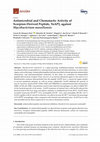
Toxins, May 30, 2018
Mycobacterium massiliense is a rapid growing, multidrug-resistant, non-tuberculous mycobacteria t... more Mycobacterium massiliense is a rapid growing, multidrug-resistant, non-tuberculous mycobacteria that is responsible for a wide spectrum of skin and soft tissue infections, as well as other organs, such as the lungs. Antimicrobial peptides had been described as broad-spectrum antimicrobial, chemotactic, and immunomodulator molecules. In this study we evaluated an antimicrobial peptide derived from scorpion Tityus obscurus as an anti-mycobacterial agent in vitro and in vivo. Bioinformatics analyses demonstrated that the peptide ToAP2 have a conserved region similar to several membrane proteins, as well as mouse cathelicidin. ToAP2 inhibited the growth of four M. massiliense strains (GO01, GO06, GO08, and CRM0020) at a minimal bactericidal concentration (MBC) of 200 µM. MBC concentration used to treat infected macrophages was able to inhibit 50% of the bacterial growth of all strains. ToAP2 treatment of infected mice with bacilli reduced the bacterial load in the liver, lung, and spleen, similarly to clarithromycin levels (90%). ToAP2 alone recruited monocytes (F4/80 low Gr1), neutrophils (F4/80 − Gr1), and eosinophils (F4/80+ Gr1+). ToAP2, together with M. massiliense infection, was able to increase F4/80 low and reduce the percentage of F4/80 high macrophages when compared with infected and untreated mice. ToAP2 has in vitro anti-microbial activity that is improved in vivo due to chemotactic activity.
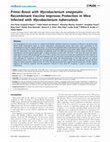
PLOS ONE, Nov 8, 2013
The development of a new vaccine as a substitute for Bacillus Calmette-Guerin or to improve its e... more The development of a new vaccine as a substitute for Bacillus Calmette-Guerin or to improve its efficacy is one of the many World Health Organization goals to control tuberculosis. Mycobacterial vectors have been used successfully in the development of vaccines against tuberculosis. To enhance the potential utility of Mycobacterium smegmatis as a vaccine, it was transformed with a recombinant plasmid containing the partial sequences of the genes Ag85c, MPT51, and HspX (CMX) from M. tuberculosis. The newly generated recombinant strain mc 2-CMX was tested in a murine model of infection. The recombinant vaccine induced specific IgG1 or IgG2a responses to CMX. CD4 + and CD8 + T cells from the lungs and spleen responded ex vivo to CMX, producing IFN-c, IL17, TNF-a, and IL2. The vaccine thus induced a significant immune response in mice. Mice vaccinated with mc 2-CMX and challenged with M. tuberculosis showed better protection than mice immunized with wild-type M. smegmatis or BCG. To increase the safety and immunogenicity of the CMX antigens, we used a recombinant strain of M. smegmatis, IKE (immune killing evasion), to express CMX. The recombinant vaccine IKE-CMX induced a better protective response than mc 2-CMX. The data presented here suggest that the expression of CMX antigens improves the immune response and the protection induced in mice when M. smegmatis is used as vaccine against tuberculosis.
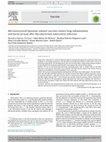
Vaccine, Jul 1, 2014
Background: Tuberculosis is a disease affecting millions of people throughout the world. One of t... more Background: Tuberculosis is a disease affecting millions of people throughout the world. One of the main problems in controlling the disease is the low efficacy of the Bacillus Calmette-Guérin (BCG) vaccine in protecting young adults. The development of new vaccines that induce a long-lasting immune response or that stimulate the immunity induced by BCG may improve the control of tuberculosis. Methods: The use of microstructured liposomes containing HspX, with or without MPL or CpG DNA adjuvants, as vaccines for tuberculosis was evaluated. The HspX-specific humoral and cellular immune responses to the different vaccine formulations were compared. Results: All vaccines containing liposome microparticles and HspX were immunogenic. Vaccines formulated with CpG DNA and HspX induced the strongest humoral and cellular immune responses, mainly by inducing interferon-␥ and tumor necrosis factor-␣ expression by both CD4 + and CD8 + T cells. HspX and MPL mainly induced CD8 + T-cell activation and specific humoral responses. When evaluated the protective efficacy of the formulations against Mycobacterium tuberculosis challenge, the microstructured liposome containing L-HspX and L-HspX-CPG DNA reduced both lung inflammatory lesions and the bacterial load. Conclusion: We have thus demonstrated, for the first time, the use of microstructured liposomes as an adjuvant and delivery system for a vaccine formulation against tuberculosis.
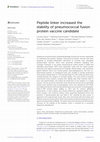
Frontiers in Bioengineering and Biotechnology
Streptococcus pneumoniae is a bacterial pathogen exclusive to humans, responsible for respiratory... more Streptococcus pneumoniae is a bacterial pathogen exclusive to humans, responsible for respiratory and systemic diseases. Pneumococcal protein vaccines have been proposed as serotype-independent alternatives to currently used conjugated polysaccharide vaccines, which have presented limitations regarding their coverage. Previously in our group, pneumococcal surface protein A (PspA) and detoxified pneumolysin (PdT) were genetically fused and the hybrid protein protected mice against pneumococcal challenge, offered higher cross-protection against different strains and showed greater opsonophagocytosis rate than co-administered proteins. As juxtaposed fusion was unstable to upscale production of the protein, flexible (PspA-FL-PdT) and rigid (PspA-RL-PdT) molecular linkers were inserted between the antigens to increase stability. This work aimed to produce recombinant fusion proteins, evaluate their stability after linker insertion, both in silico and experimentally, and enable the produc...
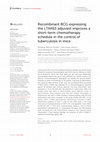
Frontiers in Immunology, Aug 31, 2022
Tuberculosis (TB) is one of the deadliest infectious diseases around the world. Prevention is bas... more Tuberculosis (TB) is one of the deadliest infectious diseases around the world. Prevention is based on the prophylactic use of BCG vaccine, effective in infants but as protection wanes with time, adults are less protected. Additionally, chemotherapy requires the use of many antibiotics for several months to be effective. Immunotherapeutic approaches can activate the immune system, intending to assist chemotherapy of TB patients, improving its effectiveness, and reducing treatment time. In this work, the recombinant BCG expressing LTAK63 (rBCG-LTAK63) was evaluated for its immunotherapeutic potential against TB. Bacillary load, immune response, and lung inflammation were evaluated in mice infected with Mycobacterium tuberculosis (Mtb) and treated either with BCG or rBCG-LTAK63 using different routes of administration. Mice infected with Mtb and treated intranasally or intravenously with rBCG-LTAK63 showed a reduced bacillary load and lung inflammatory area when compared to the group treated with BCG. In the spleen, rBCG-LTAK63 administered intravenously induced a higher inflammatory response of CD4 + T cells. On the other hand, in the lungs there was an increased presence of CD4 + IL-10 + and regulatory T cells. When combined with a short-term chemotherapy regimen, rBCG-LTAK63 administered subcutaneously or intravenously decreases the Mtb bacillary load, increases the anti-inflammatory response, and reduces tissue inflammation. These findings highlight the potential of rBCG-LTAK63 in assisting chemotherapy against Mtb.

The Journal of Immunology
Introduction: In 2013, 1.5 million died from TB, the BCG vaccine is the only TB vaccine currently... more Introduction: In 2013, 1.5 million died from TB, the BCG vaccine is the only TB vaccine currently available, but does not protect adults. The mc2CMX vaccine developed by our group was able to generate similar protection in mice, but induced higher levels of Th17 cells when compared with BCG. Objective: To study the role of Th17 cells in the protection induced by mc2CMX vaccine. Methodology: WT, IL22KO, and IL17KO mice were immunized twice with mc2CMX. Mice were challenged with Mycobacterium tuberculosis. Fifteen days after the last immunization, the lesions were collected and stained with HE, and the spleen cells were analyzed by flow cytometry before and after Mtb challenge. Results: Although WT mice induced vaccine lesions showing peripheral neutrophilia, central necrosis and few macrophages, both KO mice strains showed reduced injuries with lower neutrophils migration. Only IL-22KO and WT vaccinated mice presented vaccine specific Th1 and Th17 responses and reduced the lung and s...

Tuberculosis is an infectious disease that affects millions of people worldwide with an annual mo... more Tuberculosis is an infectious disease that affects millions of people worldwide with an annual mortality rate of 1.3 million. The mechanisms contributing to the loss of balance of immune responses and progression to active tuberculosis disease are unknown. Although CD4+ and CD8+ T cells and the cytokines they produce are crucial for protection against tuberculosis they have different roles in tuberculosis immunology. The function of CD4+ T cells has been extensively studied; however, less is known about the phenotype and function of CD8+ T cells. This study evaluated the specific expression of IFN, IL17, IL-10, and TGFand ex vivo expression of perforin and granzyme-B by CD8+ T cells from active aciloscopy uman tuberculosis tuberculosis individuals compared with latent infected individuals and non-latent infected individuals. Tuberculosis responses were correlated with the baciloscopy score. We observed that the presence of IL10 and TGFexpression and down-expression of granzyme-B in ...
Revista de Patologia Tropical, 2011
Uploads
Papers by Monalisa Trentini